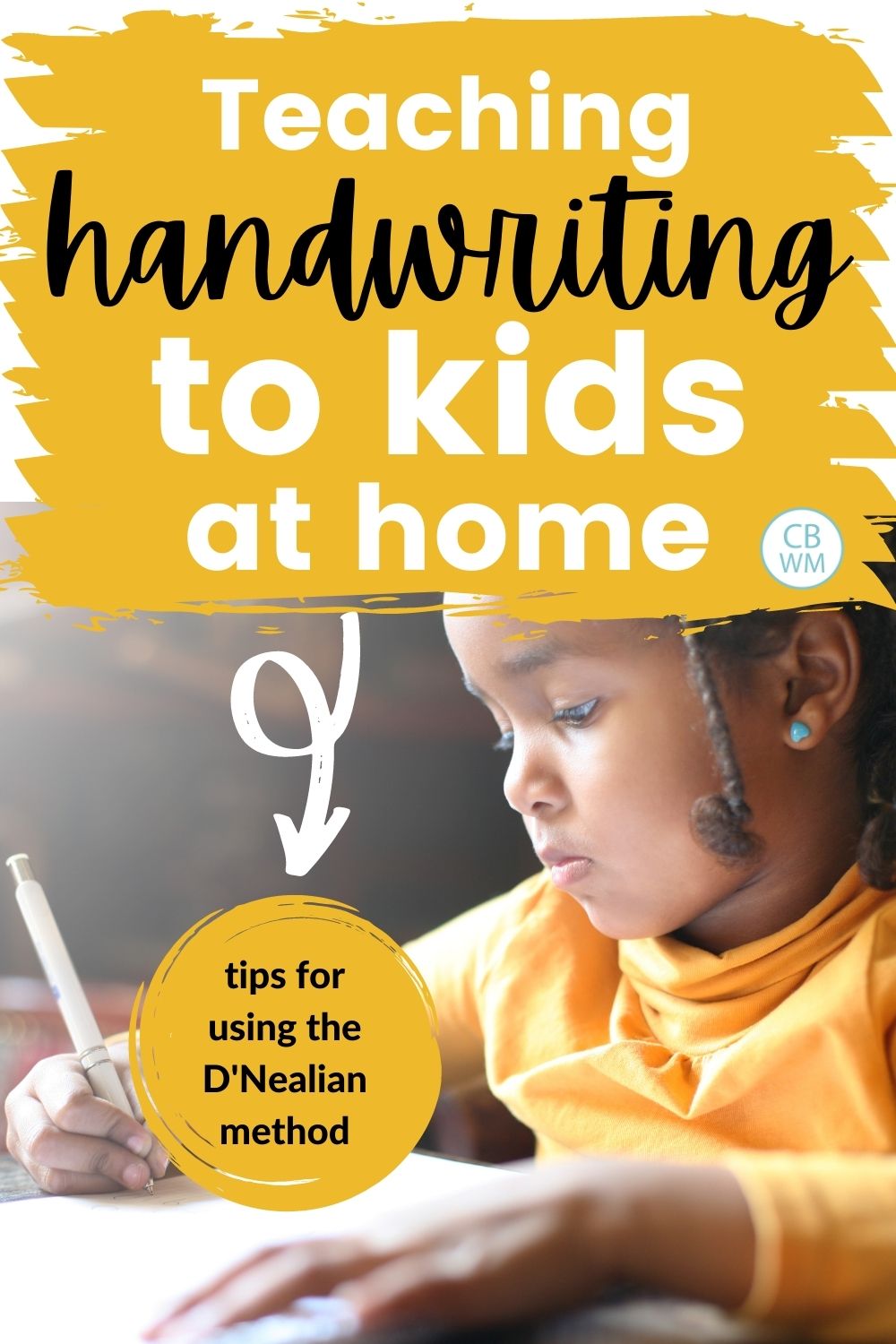All about the D’Nealian handwriting method and how to make it work even for toddlers and young preschoolers.

Here is the latest post from Susanne, a literacy specialist! This is on her favorite handwriting method. There are lots of methods out there to choose among. This is Sue’s favorite from her experience.
~~~~~~~~~~~~~~~~~~~~~~~~~~~~~~~~~~~~~~~~~~~~~~~~~~~~~~~~~~~~~~~~~
A few Babywise Moms had a handwriting discussion a little while back. We were debating over which handwriting method was the best to teach our children.
I have decided to teach my kids using the D’Nealian handwriting method. I use to teach K-8th grade and I saw great results with this handwriting program.
I know there was some discussion if it was easy for young children to print these letters since they are not all horizontal, vertical, and diagonal lines. I agree that it might be difficult for an older toddler and young preschooler to make these letters at first.
That is why I have decided to break down handwriting into some manageable steps that I believe are developmentally appropriate.
I found a pretty good webpage that shows how d’nealian handwriting (print) allows students to do one stroke for most lower case letters.
http://www.dnealian.com/
I also feel like the transition from print to cursive is easier with d’nealian.
http://www.dnealian.com/
Here is my plan of action:
1. Age 1.5-2.5: Teach letter recognition only. At this young age, fine motor skills are still developing and it is best to have your child learn letter recogonition by sight. This will prepare them to begin writing the letters at a later age. At least your child will have familiarity with the letters and their sounds prior to writing. Instead of teaching letter formation through writing, it is best to teach how to make a horizontal, vertical, diagonal, and curved lines.
2. Age 2.5-3: Teach how to write these letters large in sand, shaving cream, and other sensory mediums using his finger. I believe that pencil grip is a fine motor skill that is out of his developmental ability at this age. That is why I feel teaching how to form the letters with a child’s finger is more developmentally appropriate. Your child will learn the sensory movement for the letter, which will make it easier for him to write the letters with a writing utensil when he gets older.
3. Age 3.5-4: Teach your child how to write these letters large using chunky writing mediums such as side walk chalk, thick crayon, thick markers, etc. I feel like at this age, your child should be able to grasp a thicker, chunkier writing utensil. It is still important to keep the letters larger than normal in order to help him solidify the correct formation and movement of the letter into his long term memory. Plus at this age, it will be easier for your child to make large gross motor movements than fine motor movements required for normal handwriting.
4. Age 4-5: Teach your child how to write these letters using correct pencil grip on paper using a pencil and pencil grip (grotto grip). Start off having your child write the letters large. Then move to having your child write them normal size. Traditional handwriting skills are usually taught at this age, which is why I am plan on teaching Cooper correct pencil grip at this age. Developmentally, your child should be able to do much better with fine motor skills required in normal handwriting.
NOTE: Teach your child how to print the lower case letters first. Once your child has mastered how to print the lower case letters at age 4-5, then teach the upper case letters. The reason for this is because we use lower case letters far more often then upper case letters. Children get into a bad habit of printing in upper case letters because that is what they have been taught at first.
This method of teaching handwriting, I feel, lines up with the VAKT method of teaching. Please see my post about this method for more information.
Related Posts
- How to Teach Early Literacy Concepts About Print/Books
- Early Literacy and Phonemic Awareness
- The Benefits of Audio Books for Literacy Development
- Why The Read-Aloud Handbook is a Must-Read
- Phonics: To “B” or not to “Bu” that is the question!


Thank you so much for this post! I've been trying to teach my son (who just turned 3 today)how to hold a pencil but now I see that I'm going about it the wrong way. This makes so much sense. Thanks for your time in writing this post.
This post was so helpful, I'm working on our 3 year old Pre-k curriculum and this gives me some good guidance on what to expect with writing.
Hi! I have a question for you and was not able to find a posting regarding this so maybe you can lead me to one or help me out!My son is 15 months old, and ever since we did CIO as a 6 week old he has gone to sleep awake just fine without crying, sttn, and all that great. He is all of a sudden now crying after I put him in his crib for bedtime. He is also waking in the night crying too. I am not sure what it could be or if this is normal or not. I especially can't figure out the crying when he goes down for bedtime. Do you suggest CIO again? Has anyone ever gone through this? He is getting some teeth in, but he stops the second I come in his room and just wants to be held/rocked so they don't seem to be bothering him once he gets me in his room. Any help would be great!!Thank you !!Ashley Wheatley
Thank you – I love to see any information about handwriting. I have felt in the dark for the first four years of my older son's life because I could see he was not ready for a lot of the necessary skills, like gripping the pencil. I like your tip about teaching them lowercase letters first. Very helpful! I would like to look more into d'nealian writing for my younger son, at least. My older son is being taught a different method both by me with workbooks and at school. Handwriting information is always helpful!
Ashley, my guess would be pain. I would try to give him some pain killer about 20 minutes before the nap starts.Another possibility is that he needs longer waketime length and/or more physical stimulation. Good luck!